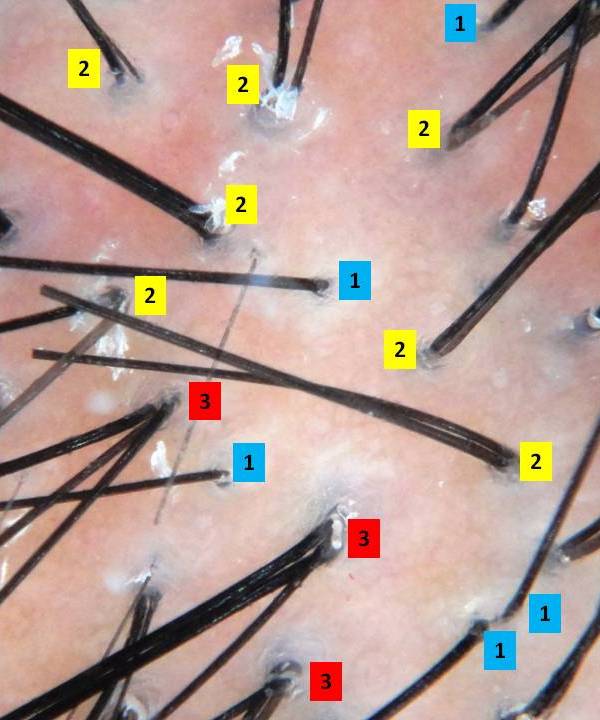Hair loss is common after pregnancy and can be extremely distressing. It typically occurs between 3 months and 6 months and can last a further 6 months. The medical term is “post-partum telogen effluvium.” Current research suggests that a drop in hormones, especially estrogen, after delivery results in hairs being shed.
Why does hair loss occur after pregnancy?
To understand why hair loss occurs after delivery, it's important to understand how hair grows normally and the changes that occur during pregnancy:
Before pregnancy
About 85-90 % of hair are in the active "growing" phase. These growing hairs lengthen in size by 1 cm each month.
About 10-15 % of hairs on the scalp in the inactive "resting" phase. These hairs are preparing to be shed.
For most women, this means that there are about 100,000 hairs on the scalp at any time and between 50 to 100 hairs are lost or "shed" every day.
During pregnancy
Due to rising estrogen levels, fewer and fewer hairs get "shed" from the scalp with each passing day. More hairs accumulate in the active growing phase.
This means that the total number of hairs on the scalp actually increases during pregnancy. Hair counts may rise from 100,000 to 110,000 hairs. The result is thicker and more dense hair.
After delivery
A decrease in hormones, especially estrogen and progesterone, causes the balance of growing and shedding hairs to again be disrupted in an effort to return back to pre-pregnancy patterns.
More and more hairs are shifted from the growing phase into the shedding phase. The result is increased hair shedding – usually all over the scalp.
This phenomenon typically occurs around 3-4 months after delivery
Full hair re-growth should occur by 12 months. A small proportion of women will note that hair density remains less than before pregnancy.
What tests are needed?
Extensive testing is not required in most patients. The resetting of the hair shedding patterns is a completely normal phenomenon, and there is no treatment or cure for post-partum hair shedding. I sometimes order blood tests to make sure that iron and thyroid levels are normal but only if there is some indication this may be a problem. All in all, I advise women that hair density should be regained by the time of celebrating their son or daughter’s first birthday. Very rarely, hair shedding can extend to 15 months. If hair shedding does not stop, further investigation into other causes of hair loss should be undertaken. Hair loss during pregnancy is abnormal, and I recommend women with hair loss in pregnancy seek medical advice.
Practical Advice for Women with Hair Shedding
1. Wash and shampoo as often needed. More hair will come out on the days that the hair is shampooed but this will not affect the long term density of hair. The use of a volumizing or thickening shampoo may help the hair look fuller and feel thicker.
2. Use a conditioner formulated for fine hair. I recommend that women with shedding avoid heavy conditioners as these tend to weigh down the hair. A conditioner formulated specifically for "fine hair" tends not to weigh the hair down as much. The conditioner should be applied only to the ends of the hair. If it is applied to the scalp and the entire hair it tends to weigh the hair down.
3. Avoid hair styles that puts stress on the hair. This includes tight braids, pigtails, cornrows, or a tight pony tail. These hair styling practices can lead to more hair being pulled out.
4. Avoid excessive combing of hair when it is wet. This can lead to more hair breakage. The use of a large tooth comb can be helpful.
5. Eat as healthy as possible.
6. Talk openly about hair loss concerns. With so much focus on the new baby, there is often little attention given to the concerns of the new mom. It is normal to be worried about hair loss. Talking with others, especially other mothers who experienced hair loss, can be helpful.
7. Wear a wig or hairpiece for a short time if it helps cope with hair loss. Very rarely, a new mom with extensive hair shedding will ask whether wigs or hair pieces are safe or whether they weigh down the hair and prevent it from breathing. Wearing a wig or hairpiece is completely safe. This can be a helpful camouflaging option for women whose scalp can be seen.
8. Consider cutting the hair shorter. This will give more lift to the hair and weigh it down less. This can help camouflage hair loss to some degree. However, cutting hair won’t make the shedding stop faster or hair grow back quicker. Shorter hair can also be much easier to manage.






